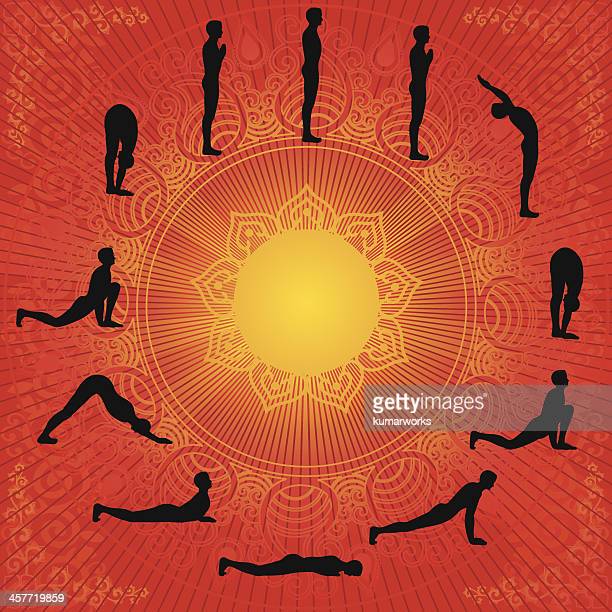Origin: The practice is believed to have originated from the Vedic tradition and has
been in
existence for over 2,500 years. It is a form of reverence and worship to the Sun, which
is
considered a powerful deity in Hindu mythology.
12 poses: The 12 poses in Surya Namaskar provide a complete workout, involving stretching, toning, and strengthening of the entire body. The poses are performed in a flowing sequence, with each pose complementing the previous one.
Pranamasana: The first pose is Pranamasana or Prayer Pose, where the hands are brought together in front of the chest, with the feet together. This pose helps to calm the mind and prepares the body for the more complex poses to follow.
Hasta Uttanasana: The second pose is Hasta Uttanasana or Raised Arms Pose, where the arms are stretched upwards, and the back is arched. This pose helps to stretch the spine and the arms.
Uttanasana: The third pose is Uttanasana or Standing Forward Bend Pose, where the body is bent forward from the waist, with the hands touching the ground. This pose helps to stretch the hamstrings and lower back.
Ashwa Sanchalanasana: The fourth pose is Ashwa Sanchalanasana or Equestrian Pose, where one leg is stretched backward on the floor while the other leg is bent at the knee, with the hands on either side of the foot. This pose helps to strengthen the legs and arms.
Dandasana: The fifth pose is Dandasana or Stick Pose, where the body is in a plank position, with the arms and legs straight. This pose helps to strengthen the arms, legs, and core.
Ashtanga Namaskara: The sixth pose is Ashtanga Namaskara or Eight-Limbed Pose, where the body is lowered to the ground, with the hands, feet, knees, chest, and chin touching the ground. This pose helps to strengthen the arms, chest, and back.
Bhujangasana: The seventh pose is Bhujangasana or Cobra Pose, where the upper body is lifted off the ground, with the hands supporting the body. This pose helps to strengthen the back and improve posture.
Adho Mukha Svanasana: The eighth pose is Adho Mukha Svanasana or Downward-Facing Dog Pose, where the body is in an inverted V-shape, with the hands and feet on the ground. This pose helps to stretch the hamstrings and calves.
Repeat: The ninth pose is Ashwa Sanchalanasana or Equestrian Pose, repeated on the other leg. The tenth pose is Uttanasana or Standing Forward Bend Pose, repeated. The eleventh pose is Hasta Uttanasana or Raised Arms Pose, repeated. The twelfth pose is Pranamasana or Prayer Pose, repeated.
Benefits: Regular practice of Surya Namaskar has numerous benefits, including improved digestion, increased blood circulation, reduced stress and anxiety, and improved overall fitness levels. It is a great way to start the day, as it helps to energize the body and mind.
Beginner-friendly: Surya Namaskar is an excellent practice for beginners, as it helps to build strength and flexibility gradually.
Holistic practice: Surya Namaskar is a holistic practice that brings balance to the body, mind, and soul.
12 poses: The 12 poses in Surya Namaskar provide a complete workout, involving stretching, toning, and strengthening of the entire body. The poses are performed in a flowing sequence, with each pose complementing the previous one.
Pranamasana: The first pose is Pranamasana or Prayer Pose, where the hands are brought together in front of the chest, with the feet together. This pose helps to calm the mind and prepares the body for the more complex poses to follow.
Hasta Uttanasana: The second pose is Hasta Uttanasana or Raised Arms Pose, where the arms are stretched upwards, and the back is arched. This pose helps to stretch the spine and the arms.
Uttanasana: The third pose is Uttanasana or Standing Forward Bend Pose, where the body is bent forward from the waist, with the hands touching the ground. This pose helps to stretch the hamstrings and lower back.
Ashwa Sanchalanasana: The fourth pose is Ashwa Sanchalanasana or Equestrian Pose, where one leg is stretched backward on the floor while the other leg is bent at the knee, with the hands on either side of the foot. This pose helps to strengthen the legs and arms.
Dandasana: The fifth pose is Dandasana or Stick Pose, where the body is in a plank position, with the arms and legs straight. This pose helps to strengthen the arms, legs, and core.
Ashtanga Namaskara: The sixth pose is Ashtanga Namaskara or Eight-Limbed Pose, where the body is lowered to the ground, with the hands, feet, knees, chest, and chin touching the ground. This pose helps to strengthen the arms, chest, and back.
Bhujangasana: The seventh pose is Bhujangasana or Cobra Pose, where the upper body is lifted off the ground, with the hands supporting the body. This pose helps to strengthen the back and improve posture.
Adho Mukha Svanasana: The eighth pose is Adho Mukha Svanasana or Downward-Facing Dog Pose, where the body is in an inverted V-shape, with the hands and feet on the ground. This pose helps to stretch the hamstrings and calves.
Repeat: The ninth pose is Ashwa Sanchalanasana or Equestrian Pose, repeated on the other leg. The tenth pose is Uttanasana or Standing Forward Bend Pose, repeated. The eleventh pose is Hasta Uttanasana or Raised Arms Pose, repeated. The twelfth pose is Pranamasana or Prayer Pose, repeated.
Benefits: Regular practice of Surya Namaskar has numerous benefits, including improved digestion, increased blood circulation, reduced stress and anxiety, and improved overall fitness levels. It is a great way to start the day, as it helps to energize the body and mind.
Beginner-friendly: Surya Namaskar is an excellent practice for beginners, as it helps to build strength and flexibility gradually.
Holistic practice: Surya Namaskar is a holistic practice that brings balance to the body, mind, and soul.











